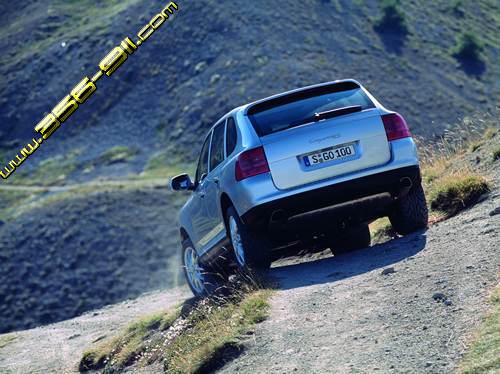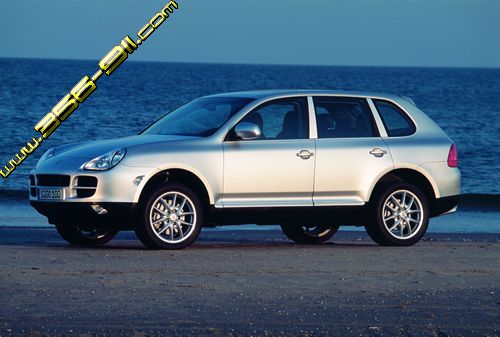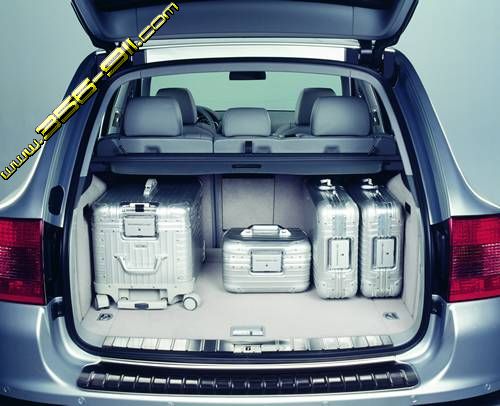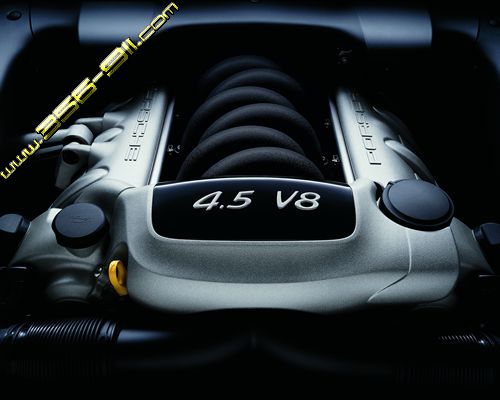Porsche Cayenne S 2004




Highlights
Impressive power and performance
The V8 power unit featured in the Cayenne S develops superior torque and pulling force even from low engine speeds.Maximum torque of 420 Newtonmetres or 310 lb-ft is main- tained consistently between 2500 and 5500 rpm.The extremely short and compact normal- aspiration V8 power unit with the two rows of cylinders facing one another at an angle of 90 °develops maximum output of 250 kW (340 bhp)at 6000 rpm from total displacement of 4.5 litres.This impressive Porsche engine incorporates 32 valves driven by two camshafts on each row of cylinders.When required to show its full performance,the Cayenne S with manual transmission fitted as standard accelerates from 0 - 100 km//h in 6.8 seconds, acceleration to 100 km/h with Tiptronic S taking 7.2 seconds.Top speed is 242 km/h or 150 mph.
Innovative four-wheel drive:Porsche Traction Management
Porsche Traction Management (PTM)featured as standard on all models in the range is crucial to the Cayenne's performance in every respect.In its basic mode,this brand-new generation of four-wheel drive distributes 62 per cent of the engine power to the rear and 38 per cent to the front wheels.Depending on the situation,up to 100 per cent of engine power and torque may be fed to the front or rear,as required.And this division of power is not determined by the lack of traction alone,but rather by sensors measuring the speed of the vehicle,its lateral acceleration,steering angle and operation of the gas pedal in order to determine the optimum degree of locking action.When driving on rough terrain,finally, PTM also provides direct access to a reduction gear in the power divider as well as a 100 per cent front-to-rear differential lock.
Porsche Stability Management featured as standard
Featured as standard in all Cayennes,Porsche Stability Management (PSM)consistently interacts with PTM but only intervenes when the vehicle is driven to the limit,stabilising the Cayenne in such a situation by applying the brakes as required on individual wheels.Should this brake function not be sufficient for stabilising the car,PSM will also intervene in engine management,controlling drive forces via the ignition and throttle butterfly.
Side impact safety system featuring thorax and curtain airbags
All three Cayennes S offer innovative technology also in the area of passive safety:Both the driver and front passenger airbag are activated by a gas generator operating in two stages. And then Porsche offers a side impact safety system made up of the thorax airbag integra- ted in the seat and a curtain airbag fitted in the roof frame.
Interior equipment:sophisticated and functional all in one
Like on the Cayenne,standard equipment - to mention just some items - includes leather seats electrically adjustable at the front,an on-board computer,tinted heat-insulating glass, electric window lifts,an alarm system as well as a CD radio with a double tuner and 12 loudspeakers.Another outstanding feature of the Cayenne S is automatic air conditioning including an activated carbon filter with individual control by the driver and front passenger.
Porsche Cayenne S
The Athlete in the Sports Utility Segment Creating the Cayenne S
Porsche has developed a truly unique sports utility vehicle (SUV) proudly presenting its heritage in terms of performance,dynamic driving characteristics, safety,and looks.And a particular forte of the Cayenne S,of course,is its superior qualities under all kinds of offroad driving conditions.
The Cayenne S stands out clearly as a true Porsche from the very beginning.Like the Turbo, the Cayenne S,almost identical in its looks,is characterised by muscular wheel arches,the headlights so typical of the marque,the V-shaped engine compartment lid,and the overall design of the vehicle typical of Porsche in every respect.The side windows are equally out- standing design features,their round and stretched lines expressing a successful combination of elegance and sportiness.The most significant signs of distinction setting the Cayenne S and the Cayenne Turbo apart from one another at very first sight are the smaller air intake scoops at the front and two instead of four tailpipes at the rear.From the side,in turn,the two models look very similar indeed,only the special design of the wheels and the brake callipers finished in titanium colour marking the difference between the two models.
V8 normal-aspiration power unit displacing 4.5 litres
The brand-new V8 normal-aspiration power unit in the Cayenne S develops maximum output of 250 kW (340 bhp)at 6000 rpm from a capacity of 4.5 litres.Featuring 32 valves and integral dry sump lubrication,this 8-cylinder sparkignition power unit comes with two rows of cylinders opposed at an angle of 90 °as well as infinitely adjustable intake camshafts. The engine itself is able to operate smoothly even at an angle of 45 °,simply ideal for offroad requirements.The crankcase is closed at the top facing the cylinder head in closed-deck design,forming a complete system together with the cylinder cooling ducts again in the interest of superior hill-climbing and downhill driving abilities.Applying the good experience gained with the engine of the Boxster through its particular cylinder geometry,Porsche's engineers have chosen specific dimensions also for the V8:The crankshaft,for example, runs with stroke of 83 millimetres or 3.27 ",which,in combination with the cylinder bore of 93 millimetres or 3.66 " carried over from the Boxster S,,provides engine displacement of exactly 4511 cc.The Cayenne S features cast aluminum pistons providing a compression ratio of 11.5:1.The cylinder head follows the two-piece concept already applied on the 911 Turbo,the separate crankcase with cup tappets and crankshaft bearings allowing use of an aluminium/silicon alloy in the cylinder head able to withstand high temperatures.
The gas charge cycle is controlled by four valves per cylinder operated directly via cup tappets with hydraulic valve play compensation.The two intake and two outlet valves per cylinder are in V arrangement.Like in Porsche's other models,VarioCam technology serves here,too,to combine a high level of specific output with superior torque,VarioCam adjusting the camshafts in this case by an angle of 25 °.The intake system featured in this V8 power unit also serves to ensure a "beefy " torque curve,,applying the principle of oscillating tube charging and requiring a perfect match of the intake manifolds in length and diameter in conjunction with optimised intake duct geometry.
Coolant is appropriately distributed in the crankcase and cylinder head by a distributor pipe positioned above the transmission.The big advantage of this design is a significant reduction in length of the entire drivetrain.Coolant is pumped by the water pump at the front end of the engine through a pipe within the interior V structure of the engine to the distributor pipe, approximately 20 per cent of the coolant flowing through the crankcase in a lengthwise direction and approximately 80 per cent flowing through the cylinder heads from the hot to the cold side (crossflow principle).Heat transmitted by the engine oil is exchanged with the coolant by means of an oil/water heat exchanger.
The exhaust system on Porsche's new V8 features two exhaust ducts connected with one another downstream of the main catalysts by a so-called crossover point improving engine torque at low speeds.The catalysts are controlled by two oxygen sensors on each precata- lyst providing information to the electronic engine control system in order to keep emissions within the limits allowed.This so-called "stereo " or dual--sensor control serves to minimise exhaust emissions,enabling both the Cayenne S and the Cayenne Turbo from the start to fulfill the EU4 standards applicable in Europe as of 2005 and the LEV standard required in the USA.The entire exhaust system is made of special stainless steel in the interest of a long running life.
Top speed 242 km/h or 150 mph
The Cayenne S has everything it takes to stand out as one of the fastest and most dynamic sports utilities.Its particular fortes include outstanding power and performance,a dynamic surge of power with a very good engine response and,at the same time,all the features re- quired for travelling in genuine style.Maximum torque of the V8 power unit is 420 Newton- 108 metres or 310 lb-ft maintained consistently between 2500 and 5500 rpm.This enables the Cayenne S with its six-speed manual gearbox fitted as standard to accelerate from 0 - 100 km/h in 6.8 seconds,acceleration to 100 km/h with Porsche 's ultra-smooth Tiptronic S automatic transmission coming in 7.2 seconds.Top speed,finally,is 242 km/h or 150 mph.
Active safety ensured by innovative four-wheel drive and PSM
All three Cayennes come as standard with Porsche Traction Management (PTM)significantly improving dynamic performance and handling in every respect.In its basic mode,this new four-wheel drive transmits 62 per cent of the engine's power to the rear wheels and 38 per cent to the front.A multiple-plate clutch operated by an electric motor and controlled elec- tronically is then able,depending on the driving situation and the driver's requirements,to feed up to 100 per cent of the engine's power either to the front or to the rear.The map- controlled front-to-rear differential lock as well as the rear axle differential available as an option respond not only to a lack of traction on the various wheels,but also interact with sensors measuring the speed of the vehicle,lateral acceleration,the steering angle and ope- ration of the gas pedal.This allows PTM to calculate the optimum degree of locking action, distributing drive forces accordingly to the front and rear wheels.The results of this intelli- gent technology,inter alia,are excellent driving stability,better steering control and enhanced control of the entire vehicle when driving to the limit.
The excellent performance of the Cayenne S on the road is supplemented ideally by equally outstanding performance offroad.When driven in light terrain,the Cayenne S is able to handle all requirements through its intelligent four-wheel drive without any modification of the traction systems.Whenever the going gets tough,on the other hand,Porsche Traction Management is able to interact with the reduced-ratio offroad gear integrated in the power divider:As soon as the driver activates the low-range mode by means of a toggle switch on the centre console,this reduction gear in the power divider takes effect,PTM and PSM preparing various control systems such as ABS,ABD and differential control for offroad motoring.These "standard " offroad qualities offered by the Cayenne models can be enhanced whenever required to an even higher level of perfection:Should the going become so tough that individual wheels lose ground contact altogether,the four-wheel drive system is linked by rigid,firm connections to keep the driver on the move.In that case all the driver has to do is flip the offroad switch a second time to obtain a 100 per cent front-to-rear wheel lock.
Also featured as standard in the Cayenne,Porsche Stability Management (PSM)is constantly in touch with PTM but only intervenes when the vehicle reaches its physical limits.Master- minding major systems such as ABS,ASR and the ABD automatic brake differential,PSM cuts in,for example,immediately when the Cayenne starts to over-or understeer,telling PTM to open the differential locks in order to enhance the vehicle's stability by applying the brakes specifically on individual wheels.And should the brake function not be sufficient to stabilise the Cayenne,PSM will intervene also in the engine management,controlling drive power by means of the ignition and throttle butterfly.
Ideal suspension with a brake system typical of Porsche
All models in the Cayenne range boast a new axle concept combining supreme performance and dynamic driving characteristics with superior safety,driving comfort and offroad qualities.The front axle is an extra-large double-track control arm configuration resting on a subframe mounted elastically on extra-large rubber bearings and thus reducing drive noise to a minimum.Forces acting on the suspension are likewise kept to a minimum by the big distance between the two track control arms.The rear axle is an elaborate multiarm concept able to handle both traction forces and any kind of load with superior behaviour and driving qualities.The subframe resting on large hydraulically-dampened rubber mounts, in turn,ensures extra comfort and refinement on the road,with any undesired dive or squat when applying the brakes and accelerating being reduced to a minimum by the special kinematic configuration of the axle.Long spring travel,finally,makes offroad motoring more comfortable and refined,inward and rebound spring travel on the steel-spring suspension of the Cayenne S measuring 104 and 116 millimetres (4.09 and 4.57 "),respectively,on the front axle,and 135/98 millimetres (4.57/3.86 "),respectively,at the rear.With ground clearance of 217 millimetres or 8.54 ",the maximum embankment angle is 29.1 °at the front and 25.7 °at the rear.The ramp angle,in turn,is 20.4 °and the Cayenne S is able to cross bodies of water up to 500 millimetres or 19.7 " deep..Clearly,figures of this quality make the Cayenne S a genuine offroad specialist even in its "basic " trim..And as an option the Cayenne S is available with air suspension providing even greater ground clearance and, as a result,even better offroad driving qualities.
Moving on to the brakes,the Cayenne S differs from the Cayenne Turbo only in its looks through the titanium-coloured brake callipers on the top-of-the-range model.The elaborate brake system and the technical features of the brakes,therefore,are the same in both cases, the front axle coming with innervented,350-millimetre (13.78 ")large brake discs featuring 110 Model Year 2004 o Cayenne S.six-piston monobloc fixed callipers made of aluminium.At the rear brake discs measuring 330 millimetrs or 13.00 " in diameter,,plus four-piston monobloc fixed callipers,are quite sufficient to safely slow down even a fully loaded Cayenne towing a trailer.The standard tyres are again the same as on the Cayenne Turbo,with 18-inch ligh-alloy wheels all round running on 255/55 R 18 tyres.Larger wheels measuring 19 and even 20 inches are avail- able as special equipment.
Passive safety of the highest standard
Porsche's particular know-how in lightweight steel technology plays a significant role above all in the body of the car.Incorporating the most advanced and sophisticated materials,the Cayenne combines excellent passive safety with exceptionally good body stiffness.And fea- turing high-strength steel throughout 60 per cent of its body structure,the Cayenne ranks right at the top in the automotive industry in the use of such sophisticated,high-quality material.An unusual and particularly effective asset is the combination of various materials requiring special skills in joining technology.One innovation deserving particular mention in this context is the use of multi-phase steel,that is dual-phase and TRIP steel grades offering enhanced strength and good moulding qualities compared with conventional high-strength steel.The B-pillars at the inside and the reinforcements in the A-and B-pillars providing extra safety in a rollover,for example,are made of TRIP steel.Multiphase steel offering supreme strength and rigidity is used at the bottom on the seat crossbars and on the rear floor cross- bars.Use of tailored blanks,tailor-made components already featured in Porsche's sports cars,ensures that all structures along the chassis legs and on the roof frame at the side are both light and extremely stable at the same time.
The front section of the car features a combination of longitudinal support and crossbars ensuring intelligent distribution of forces in a collision:Three load levels on top of each other take up deformation energy,spread out forces into the stiff longitudinal floor support, the side-sill,tunnel and door shaft areas,and thus minimise any deformation of the interior. The highly resistant passenger cell,in turn,offers supreme passenger safety and protection. And last but not least,the shell structure of the sills is quite unusual,supplemented by a high-strength tube element inside the sills to reduce intrusion into the vehicle when hitting a pole from the side. In this case the thorax airbag integrated in the seat and the curtain airbag fitted in the roof frame and protecting occupants both front and rear ensure superior safety.In a head-on collision the full-size airbags for the driver and front passenger are each activated by a two- stage gas generator reducing the forces acting on the occupants.
Equipment and features - sophisticated and functional
Inside,the Cayenne is functional and sophisticated in its wide range of features.Like on the six-cylinder Cayenne the wide range of standard features - to mention only a few examples - includes leather seats electrically adjustable at the front,an on-board computer,tinted heat- insulating glass,electric window lifts,an alarm system,and the steering column adjustable for both height and reach.The automatic air conditioning including an activated carbon filter with separate control for the driver and front passenger as well as a CD radio with a double-tuner and 12 loudspeakers all featured as standard ensure a pleasant atmosphere inside the car as well as supreme sound quality.
The luggage compartment in the Cayenne S is the same as on the entry-level model,featu- ring a ski-bag,a partition net and a complete cover on top and offering capacity of 540 litres. The rear-seat backrests can be tilted to the front either with a 40:60 or 60:40 split or all the way from one side to the other,increasing luggage capacity in the process to a maximum of 1770 litres.
